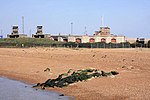Harwich Harbour Ferry

The Harwich Harbour Ferry is a foot and bicycle ferry for 58 passengers that runs from April until end of October between Ha'penny Pier near Harwich to Landguard Fort near Felixstowe and Shotley marina. As well as for local traffic, this ferry can be used as a short cut on the Suffolk Coast Path; it takes bicycles, prams, e-bikes and is used by National Cycle Route NCR 51 and the North Sea Cycle Route. The ferry service started in 1912 and was operated from 1925 until 1992 by the MV Brightlingsea. The service was later started with the MV Explorer 12, a Sea Truck, which is owned by Austrian Christian Zemann and his English wife Lucy Zemann and licensed to carry 12 passengers.As of 2016 the service is provided by the simply-named Harbour Ferry. The boat was once a lifeboat from the liner SS Canberra and is now licensed and equipped for 58 passengers.
Excerpt from the Wikipedia article Harwich Harbour Ferry (License: CC BY-SA 3.0, Authors, Images).Harwich Harbour Ferry
East Suffolk Grange Farm
Geographical coordinates (GPS) Address Nearby Places Show on map
Geographical coordinates (GPS)
| Latitude | Longitude |
|---|---|
| N 51.939444444444 ° | E 1.3047222222222 ° |
Address
Grange Farm
IP11 2XD East Suffolk, Grange Farm
England, United Kingdom
Open on Google Maps








